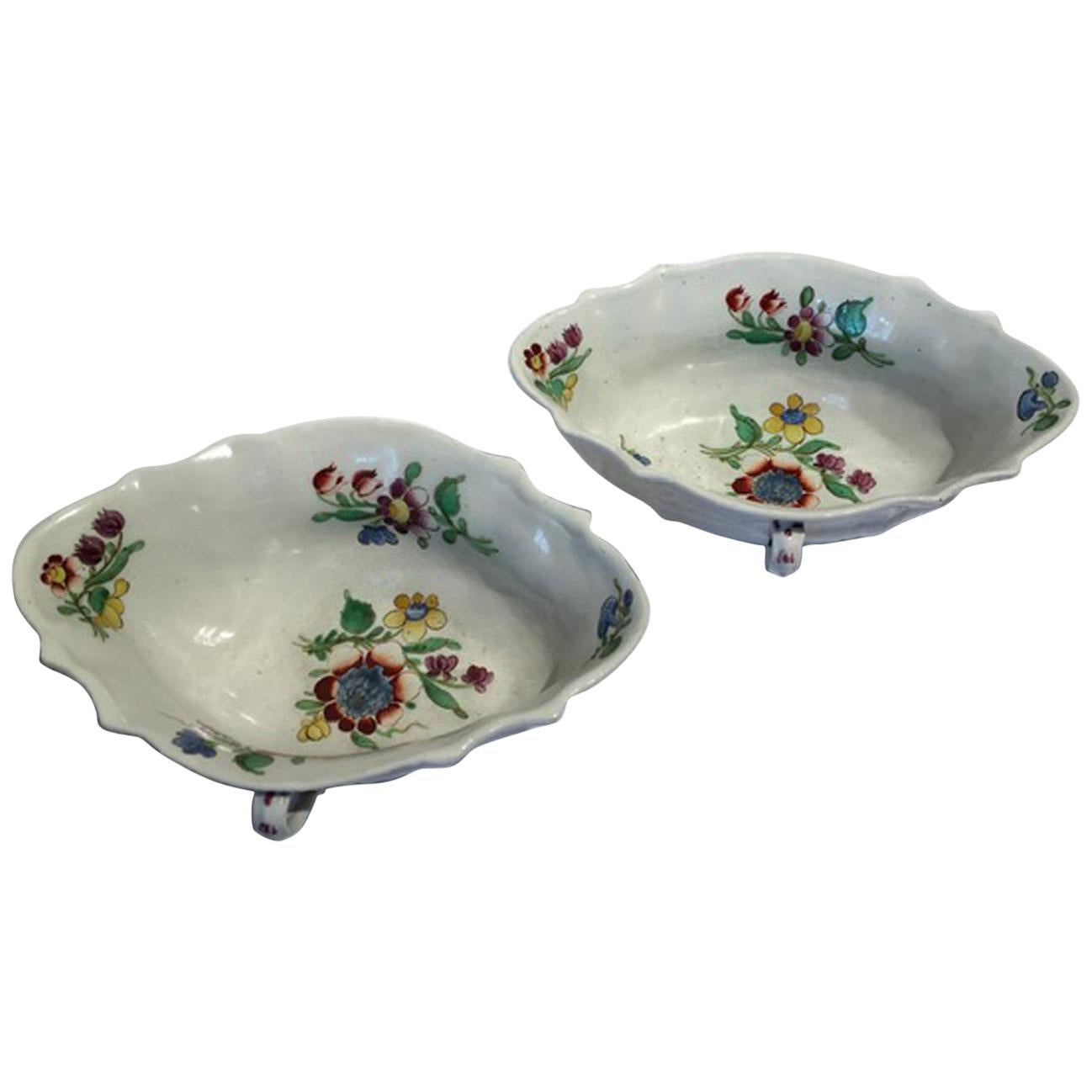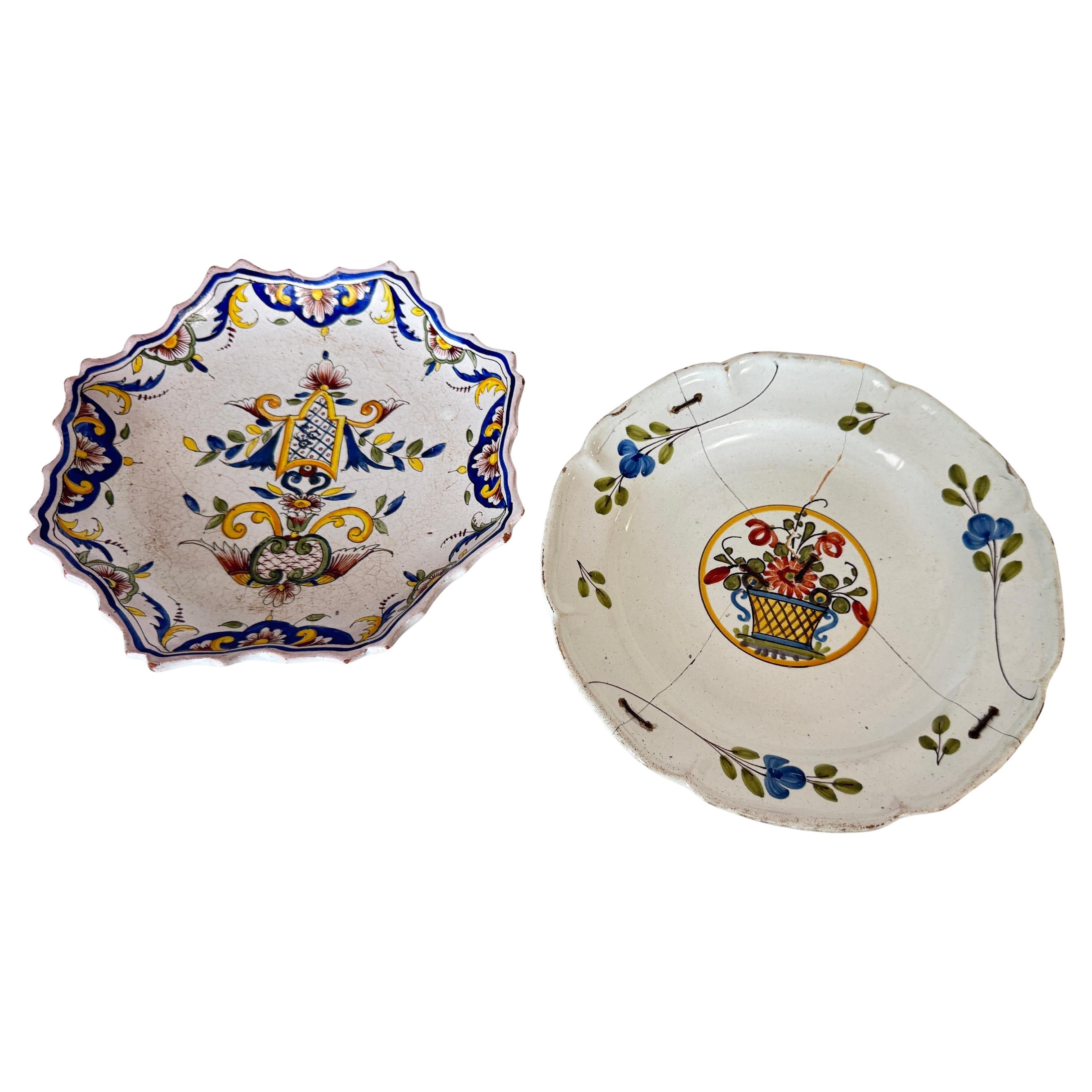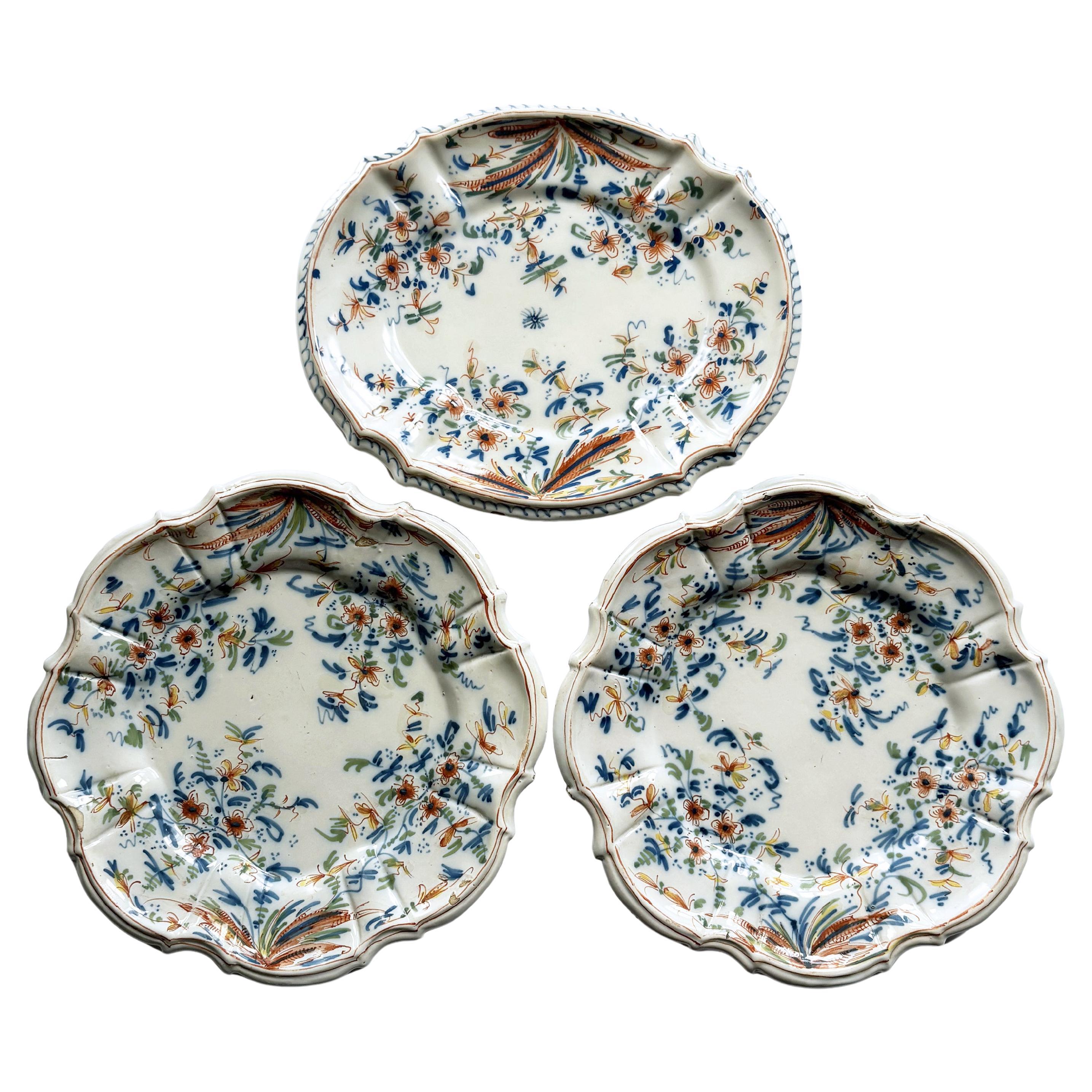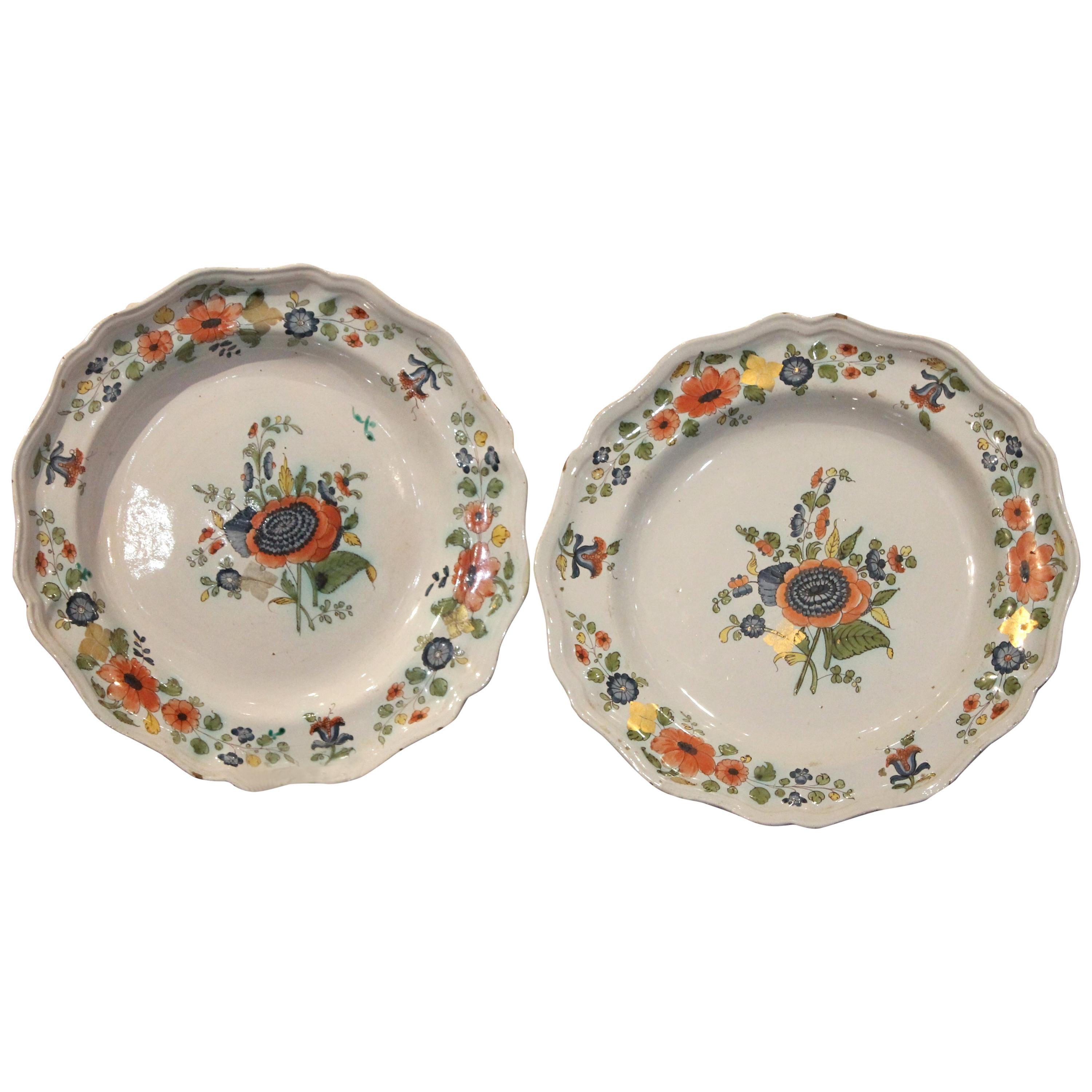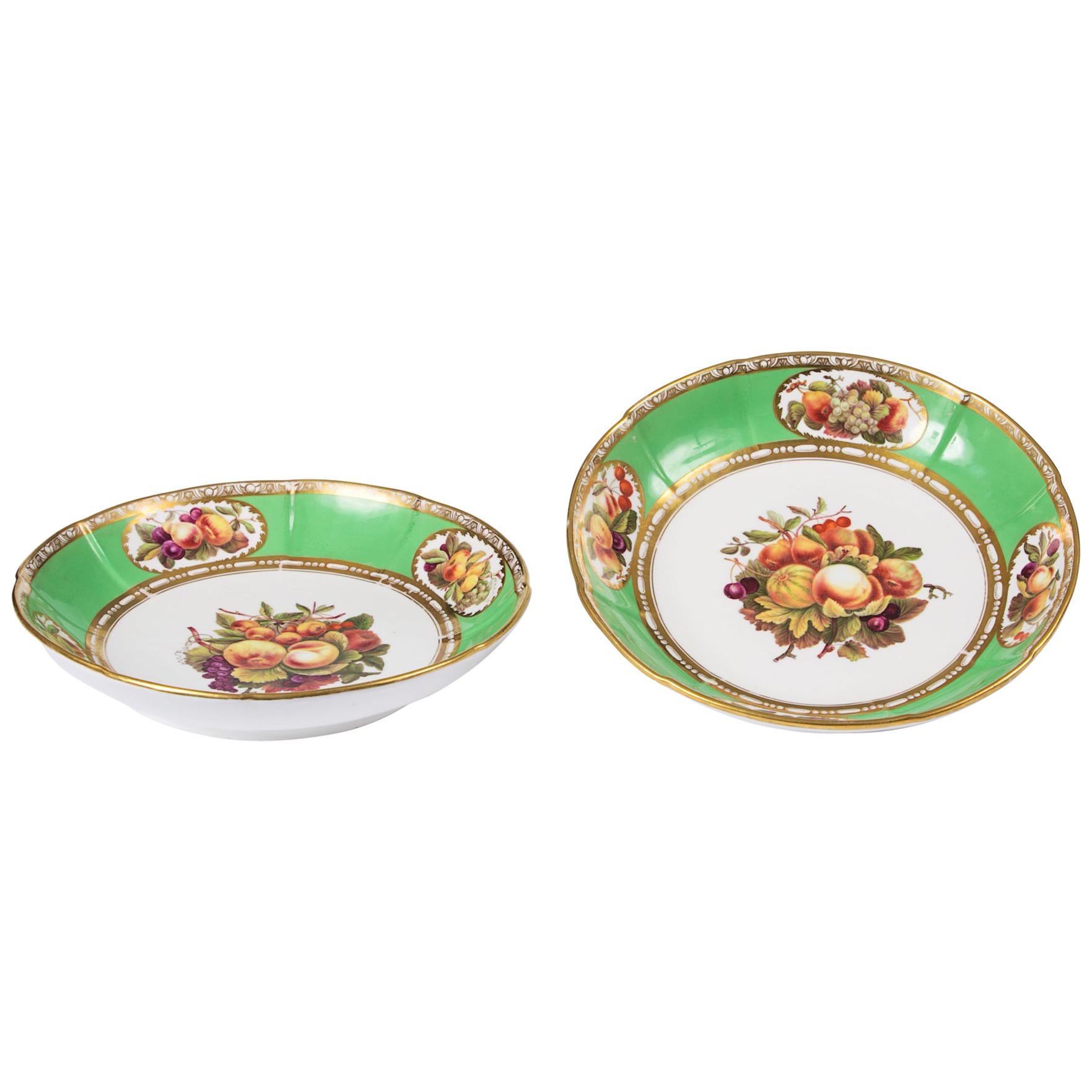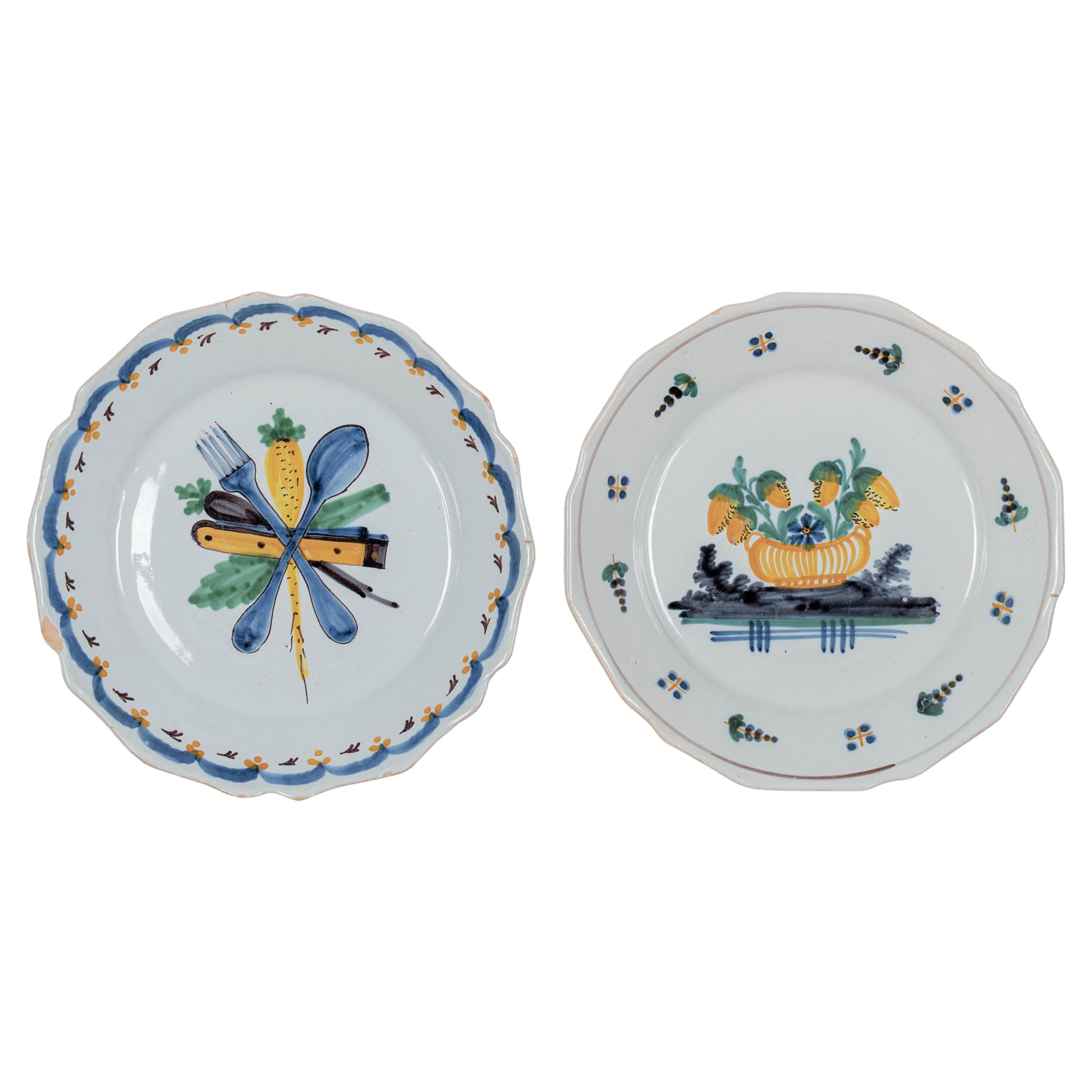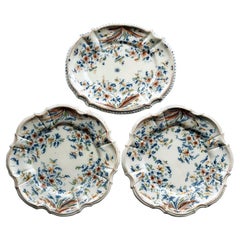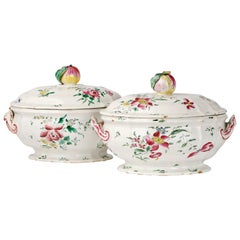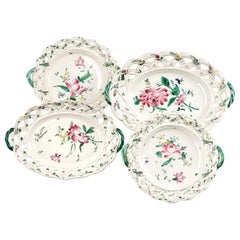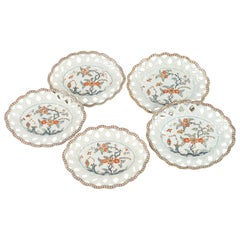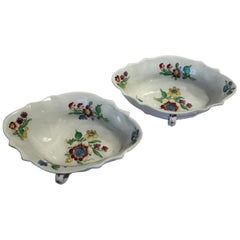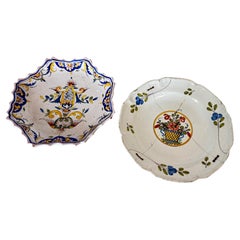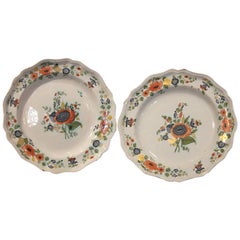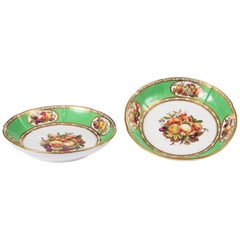Articoli simili a Two Small Italian Dishes Antonio Maria Coppellotti Manufacture, Lodi, Circa 1740
Caricamento del video
Vuoi altre immagini o video?
Richiedi altre immagini o video al venditore
1 di 18
Two Small Italian Dishes Antonio Maria Coppellotti Manufacture, Lodi, Circa 1740
3500 €per set|IVA inclusa
Informazioni sull’articolo
Two small dishes
Antonio Maria Coppellotti Manufacture
Lodi, Circa 1740
High fire polychrome maiolica
They measure: diameter 7.08 in(18 cm)
Weight: 0.37 lb (170 g)
State of conservation: one is intact, with only minor chips along the edges and a thin fêlure; the second one is broken into three pieces with visible restoration on the back.
The pair of small plates features a traditional form without a support ring, with a short, slightly inclined, and mixed-line profile. The rim is undulating, scalloped, and bordered in brownish-brown.
The high-fire polychromy decoration is executed over a thick, cream-white enamel in the first one and slightly darker in the other, with a few small air bubbles in both. In one specimen, positioned at the center of the composition, there is an "aerial" grassy mound upon which rests a small tree accompanied by two fruits: a plum and a peach. In the second dish, a leafy branch is painted with two small pears, and a polychromatic bird perches on it. In both dishes, the rim is decorated with the alternating pattern of flowering branches and polychromatic insects with long legs. Both of them bear the monogram "AMC" on the reverse, outlined in light green for one and brown for the other. The comparison of the "AMC" monogram confirms the attribution: reference can be made to some specimens exhibited in the Lodi exhibition of 1995. (M. L. Gelmini, Maioliche lodigiane del ‘700, Milano 1995, pp. 112-115; nn. 103-104).
Very close in terms of morphology and decoration, but slightly larger in size, is a dish (inventory number 325) with a similar ornamentation, now preserved in the Applied Arts collections of the Castello Sforzesco in Milan. (R. Ausenda, a cura di, Musei e Gallerie di Milano. Museo d’Arti Applicate. Le ceramiche. Tomo secondo, Milano 2000, p. 191, n. 231).
The two small dishes are indeed certain works of the Lodi manufacture by Antonio Maria Coppellotti, adhering to all of its compositional standards. These works can be placed within the peak period when, following Baroque canons, the "fruit" decoration became one of the most requested subjects. This style was then adopted not only by nearby Lombard factories but also by the Antibon manufacture in Bassano (G. Ericani, P. Marini, N. Stringa La Ceramica degli Antonibon, Milano 1990), and further in the Marche region (G. Biscontini Ugolini, Ceramiche pesaresi dal XVIII al XX secolo 1986 pp. 41-44).
The painting expertise of the decorators from Lodi, especially in color control, set a standard: the red, sourced from now-depleted Eastern quarries and known as "bolo armeno," was carefully managed during firing. This was achieved by applying a thin brushstroke of enamel over the sections affected by the chromatic range. This technique helped contain the "boiling" of the color during firing, resulting in remarkable outcomes where the relief and red-orange color characterize the production.
The first mention of the Coppellotti family as potters comes from archival documents which record the official request of an unknown Giovanni Coppellotti to open a majolica factory in Lodi in 1674. The factory, located near the church of St. Philip seems to have been immediately quite successful. However, it was only in 1679, when the management of the factory passed to Antonio Giovanni Maria Coppellotti – the son or perhaps grandson of the original Giovanni - that the production reached the peak of success and became an example for the main Italian manufactures of the time, especially those in Veneto and Liguria. In 1728 the factory had to move outside the city walls at the behest of the authorities, who feared the possibility of fires.
The activity continued until about 1750, the year of Anton Maria's death and resumed later with his son, Bassano Coppellotti, under the guide of some other directors, among whom we note: first, G. Moroni, followed by Giulio Berinzaghi and in 1771 Pedrinazzi. Finally, in 1787 a new municipal ordinance ordered the definitive closure of the manufactory.
The maiolica produced during the initial period are characterized by the use of a thick, velvety enamel and have ornaments ranging from monochrome turquoise with Italian (ruins, castles, flowers) and French motifs ("rabeschi", ramage), to decorations in the manner of Chinese porcelain and oriental inspiration.
Of particular importance are ornaments of Baroque fruit which show the amazing relief effects produced by using the red tone called "Armenian bolus". This great variety of decorations appeared between 1735 and 1740 by which time, alongside the production of turquoise monochrome, polychromy with high fire technique was firmly established. The brand precisely identifying the maiolica of this factory is rare and uses a woven "AMC" monogram. It was sometimes done in different colors and was sometimes accompanied by the names of the painters and modelers of the manufacture.
Bibliografia di riferimento:
C. Baroni, La maiolica antica di Lodi, in “Archivio storico lombardo” LVIII, 1930, pp. 448 s., 455-457;
A. Minghetti, I ceramisti italiani, Roma 1946, p. 129;
S. Levy, Maioliche settecentesche lombarde e venete, Milano 1962, pp. 15-17, tavv. 121-150;
G. Gregorietti Museo Poldi Pezzoli, Maioliche di Lodi, Milano e Pavia (catal.), Milano 1964, pp. 15 s., con ill.;
A. Novasconi - S. Ferrari - S. Corvi, La ceramica lodigiana, Milano 1964, pp. 23, 27, 34-36, 47, ill. pp. 53-121;
O. G. C. Sciolla, Museo civico di Lodi, Bologna 1977, pp. VIII s.; tavv. pp. 72-76, 78;
M. L. Gelmini, Maioliche lodigiane del ‘700, Milano 1995, pp. 112-115; nn. 103 - 104;
R. Ausenda, a cura di, Musei e Gallerie di Milano. Museo d’Arti Applicate. Le ceramiche. Tomo secondo, Milano 2000, p. 191, n. 231;
Felice Ferrari, La ceramica di Lodi, Lodi 2003.
- Attribuito a:Antonio Maria Coppellotti (Fabbricante)
- Dimensioni:Altezza: 1,8 cm (0,71 in)Diametro: 18 cm (7,09 in)
- Venduto come:Set di 2
- Stile:Barocco (Del periodo)
- Materiali e tecniche:
- Luogo di origine:
- Periodo:
- Data di produzione:Circa 1740
- Condizioni:Riparato: One is intact, with only minor chips along the edges and a thin fêlure; the second one is broken into three pieces with visible restoration on the back. Usura compatibile con l’età e l’utilizzo.
- Località del venditore:Milano, IT
- Numero di riferimento:1stDibs: LU4352241507052
Informazioni sul venditore
4,3
Venditore professionale selezionato
Ogni venditore supera rigorosi standard di autenticità e affidabilità
Fondazione nel 1860
Venditore 1stDibs dal 2018
21 vendite su 1stDibs
Associazioni
International Confederation of Art and Antique Dealers' Associations
- SpedizioneRecupero del preventivo…Spedizione da: Milano, Italia
- Politica di reso
Alcune parti di questa pagina sono state tradotte automaticamente. 1stDibs non può garantire che le traduzioni siano corrette. L’inglese è la lingua predefinita del sito.
Garanzia di autenticità
Nell’improbabile caso in cui si verifichi un problema con l’autenticità di un articolo, contattaci entro un anno per ottenere un rimborso completo. DettagliGaranzia di rimborso
Se il tuo articolo non corrisponde alla descrizione, è danneggiato durante il trasporto o non arriva, contattaci entro 7 giorni per un rimborso completo. DettagliAnnullamento entro 24 ore
Hai un periodo di tolleranza di 24 ore per annullare il tuo acquisto, senza necessità di fornire spiegazioni.Venditori professionali selezionati
I nostri venditori di livello internazionale devono aderire a rigorosi standard di servizio e qualità, garantendo l’integrità delle inserzioni.Garanzia miglior prezzo
Se scopri che un venditore ha pubblicato altrove lo stesso articolo a un prezzo più basso, applicheremo lo stesso prezzo.Consegna globale affidabile
La nostra rete di vettori leader del settore offre opzioni di spedizione specializzate in tutto il mondo, inclusa la consegna personalizzata.Altro da questo venditore
Mostra tuttoThree Dishes, Antonio Maria Coppellotti Factory, Lodi, Italy, Circa 1745
Di Antonio Maria Coppellotti
Pair of round dishes and a small oval tray
Antonio Maria Coppellotti factory
Lodi, circa 1745
High fire polychrome maiolica
Dishes size: diameter 9.44 in, height 0.78 in (24 cm, 2 c...
Categoria
Di antiquariato/d’epoca, 1740s, Italian, Rococò, Delft e Faïence
Materiali
Maiolica
Coppia di zuppiere in maiolica italiana, manifattura Ferretti, Lodi CIRCA 1770 - 1780
Di Antonio Ferretti
Coppia di zuppiere in maiolica
Antonio Ferretti Produzione
Lodi, circa 1770-1780
Maiolica policroma decorata "a piccolo fuoco".
a - 8,66 x 11,02 x 7,48 pollici (22 x 28 x 19 cm) ...
Categoria
Di antiquariato/d’epoca, Anni 1770, Italiano, Rococò, Ceramiche
Materiali
Maiolica
Quattro piatti antichi italiani, Antonio Ferretti, Lodi, 1770-1780 ca.
Di Antonio Ferretti
Assortimento di 4 piatti con bordo intrecciato
Antonio Ferretti Produzione
Lodi, circa 1770-1780
Maiolica policroma decorata "a piccolo fuoco".
Misure: 14 x 10 pollici (35,5 ...
Categoria
Di antiquariato/d’epoca, Anni 1770, Italiano, Neoclassico, Ceramiche
Materiali
Maiolica
Piatti antichi in maiolica Pasquale Rubati, Milano Circa 1770-1780
Di Pasquale Rubati
Cinque piatti ovali in maiolica con bordo forato
Produzione di Pasquale Rubati
Milano, 1770-1780
Tre piccoli piatti ovali da 26 cm x 19,5 cm (10,23 in x 7,67 in)
Due grandi piatti ov...
Categoria
Di antiquariato/d’epoca, Anni 1770, Italiano, Rococò, Ceramiche
Materiali
Maiolica
Antichi piatti in maiolica con fiori, manifattura lombarda, 1770-1780 Circa
Assortimento di piatti
Manifattura lombarda
1770 - 1780 circa
Maiolica policroma decorata "a piccolo fuoco".
Due piatti grandi: diametro di 37,5 cm; peso di 2,07 kg.
Sette piatt...
Categoria
Di antiquariato/d’epoca, Anni 1770, Italiano, Rococò, Ceramiche
Materiali
Maiolica
Coppa in maiolica italiana Ferretti Lodi, circa 1770 - 1780
Di Antonio Ferretti
Coppa puerperale in maiolica
Antonio Ferretti Produzione
Lodi, circa 1770 - 1780
Maiolica policroma decorata "a piccolo fuoco".
Misura: 4.3 x 6.8 x 5.3 pollici (11 x 17,5 x 13,5 ...
Categoria
Di antiquariato/d’epoca, Anni 1770, Italiano, Rococò, Ceramiche
Materiali
Maiolica
Ti potrebbe interessare anche
Italia 18° secolo Italia Richard Ginori Doccia Coppia di salsiere in porcellana
Di Richard Ginori
Si tratta di un'elegante coppia di salsiere in porcellana con disegni floreali in rosso e blu.
È bellissimo per un tavolo d'arredamento o da collezionare.
La produzione di questa n...
Categoria
Di antiquariato/d’epoca, Metà XVIII secolo, Italiano, Barocco, Porcellana
Materiali
Porcellana
1520 € Prezzo promozionale / set
20% in meno
Coppia di piatti di maiolica francese del XIX secolo - stile Rouen dipinti a mano
Coppia di piatti di maiolica francese del XIX secolo - stile Rouen dipinto a mano - toni blu, gialli e ruggine - autentico antiquariato
Descrizione:
Si tratta di una coppia di piatt...
Categoria
Di antiquariato/d’epoca, XIX secolo, Francese, Stile provenzale, Delft e...
Materiali
Faenza
Coppia di piatti da pranzo decorativi in porcellana multicolore dipinti a mano del XVIII secolo
Di Meissen Porcelain
Questi due bellissimi e antichi piatti di porcellana multicolore dipinti a mano risalgono al 1700.
Ogni piatto ha bordi sagomati con rilievi modellati e rifiniti, mentre lo sfondo i...
Categoria
Di antiquariato/d’epoca, XVIII secolo, Tedesco, Rococò, Piatti
Materiali
Porcellana
Coppia di piatti da dessert in porcellana Spode del primo Ottocento Regency
Di Spode
Coppia di piatti da dessert in porcellana dipinti a mano, di forma circolare con bordo dorato, decorati sul bordo con un motivo a uovo e dardo dorato su fondo verde con quattro medag...
Categoria
Di antiquariato/d’epoca, Anni 1810, Britannico, Regency, Alzate, vassoi ...
Materiali
Porcellana
Set di 2 piatti in maiolica francese del XVIII secolo
Set di due piatti in maiolica francese del XVIII secolo con decorazione primitiva dipinta a mano. Piccole scheggiature e perdite di smalto sui bordi del bordo smerlato. Non si notano...
Categoria
Di antiquariato/d’epoca, Fine XVIII secolo, Stile provenzale, Delft e Fa...
Materiali
Faenza
Coppia di piatti decorati da Jefferyes Hamett O'Neale, Chelsea, 1755 ca.
Di Chelsea Porcelain
Coppia di piatti a forma di "Warren Hastings", con raffinate modanature in stile rococò, decorati da Jefferyes Hamett O'Neale con oche e altri uccelli nelle riserve; tipici getti e r...
Categoria
Di antiquariato/d’epoca, Metà XVIII secolo, Inglese, Rococò, Porcellana
Materiali
Porcellana
4464 € / set
Spedizione gratuita
